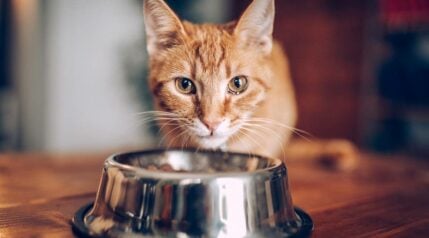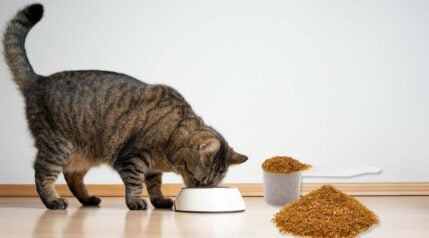When you purchase through links on our site, we may earn a commission. Here’s how it works.
Picking economical yet quality cat food for your furry friend can be extremely challenging. The sheer variety of cat food is mind-boggling. Maybe you’ve tried reading the back label but got lost in the ingredient list. What’s carrageenan or meat by-product? Three ingredients in, and your eyes begin to glaze over. The pet-food industry is big business; companies use clever marketing tactics to get humans to pick their products over competitors. How do you know if you’re choosing a quality cat recipe?
We’ve all heard of Purina. As one of the oldest pet-food companies, Purina has made a name for itself in the wide world of pet food. Purina ONE cat food is just one brand in the Purina cat food lineup that includes Kit & Kaboodle, Fancy Feast, Purina Pro Plan, and more. Is Purina ONE a good choice for your pet—and your wallet? This article helps you understand feline nutrition and if Purina ONE fits your cat’s needs. We’ll cover brand history, ingredient quality, recipe formulations, and cost.
- 5 Key Features
- Brand History
- Where Is It Made?
- Has Purina One Ever Been Recalled?
- What Ingredients Should I Look For In Cat Food?
- Purina One Cat Food Ingredients
- Purina One Cat Food Recipes
- Pros And Cons Of Purina One Cat Food
- How Much Is Purina One Cat Food?
- How Does Purina One Cat Food Compare?
- Final Thoughts
5 Key Features
- A Purina premium food line featuring natural ingredients
- Wet and dry food options
- Recipes for kitten, adult, and senior cats
- Specific formulas include indoor, healthy weight, hairball, grain-free, and true instinct (high protein or high-protein/grain-free)
- Offer an online quiz to find the food formula that best fits your cat’s needs and preferences
Brand History
Purina began in 1894 with founder William H. Danforth’s animal feed company Purina Mills. While initially producing only feed for farm animals, Danforth began researching dog nutritional needs in 1926, opening a research center in Gray Summit, Missouri, that performed feeding studies and dietary tests. The first pet-specific line by Purina was Purina Dog Chow, released in 1926 as a pet food for hunting and farm dogs. In 1956, Purina Dog Chow became the first pet food to use extrusion technology to form dog food into distinctive shapes, known as “kibble” today.
Purina expanded to cat kibble in 1962, introducing Purina Cat Chow to support the growing population of house cats in America. In 1986, Purina sold its animal feed business to focus on pet food. That same year, Purina ONE was introduced as Ralston Purina’s first premium pet food. Purina ONE Natural Blends promised to use natural ingredients and was the first line of natural pet food to have national distribution in grocery and retail stores.
Swiss multinational food and drink processing conglomerate Nestle acquired Ralston Purina in 2001 for $10.3 billion. The two businesses merged under the Purina brand, including Nestle’s other pet brands Friskies, Fancy Feast, Alpo, and Mighty Dog.
Today, Purina ONE offers three specific product lines: +Plus Tailored Cat, True Instinct Cat, and Microbiome Cat. +Plus Tailored caters to unique needs, including weight management, indoor, hairball control, urinary tract health, and sensitive systems. True Instinct Cat recipes are high-protein formulas that also include grain-free options. Microbiome Cat recipes include prebiotic fiber to support digestion and microbiome balance.
Where Is It Made?
Purina manufactures 99 percent of its cat products in the United States in Purina-owned and operated facilities. Purina’s food traceability map, last updated in January 2021, shows where most ingredients used in Purina pet foods are sourced.
Has Purina One Ever Been Recalled?
According to the U.S. Food and Drug Administration (FDA), Purina ONE cat food has never been recalled. Purina has five FDA recalls, with the latest being in March 2023. The Nestle Purina PetCare Company expanded its voluntary recall of Purina Pro Plan Veterinary Diet EL Elementals prescription dog food due to potentially elevated vitamin D levels.
What Ingredients Should I Look For In Cat Food?
Cats are obligate carnivores, requiring a high-meat diet, moderate fat, and few carbohydrates. Cats need protein for energy, growth, and overall body function. Protein should be the foundation of every meal.
Protein is made up of amino acids. One amino acid, taurine, is essential to felines. When cat food first entered the marketplace, it lacked sufficient amounts of this amino acid and caused health problems from taurine deficiencies, including blindness and heart disease. According to Purina, in 1961, it was the first company to add taurine dry cat food.
The second-most essential nutrient for cats is fat. Fat is a concentrated energy source and gives cat food a delicious taste. Fats are made up of fatty acids. Some fatty acids, like omega-3 fatty acids, are essential to cats. These fatty acids support your cat’s joints, eyes, skin, and coat. Fat also helps your feline absorb fat-soluble vitamins A, D, E, and K and transfer the vitamins throughout the body.
Carbohydrates are comprised of sugars, starches, and fiber. While cats need minimal amounts of carbohydrates, they do benefit from fiber. Fiber helps move toxins through the digestive system. When combined with water, fiber can protect a cat against constipation. As a bonus, fiber also breaks down hairballs.
Besides the major macronutrients, cats need vitamins and minerals for a healthy diet. As long as you’re feeding your cat a high-quality, well-balanced formula from various sources, they should be getting enough vitamins and minerals through their food. Most companies also fortify their recipes with synthetic vitamins and minerals.
The final and sometimes overlooked component of cat food is water. Cats need moisture in their diet to support the urinary tract and prevent bladder stones and crystals. If your cats eat dry kibble, they are likely not getting much water in their diet, leading to health problems in the future.
Choose a cat food with high-quality proteins and fats from animal sources. Avoid unnecessary ingredients like fillers, chemical additives, artificial colors and flavors, meat by-products, and genetically modified foods. Four ingredients to look for are:
- Animal-based proteins
- Healthy fats, especially omega-3 fatty acids
- L-taurine amino acid
- Fibrous carbohydrates (pumpkin, carrots, and spinach) or prebiotic fiber (chicory root, inulin, and oats)
Purina One Cat Food Ingredients
Purina ONE ingredients vary by recipe, but the company claims to use high-quality, natural ingredients in all of its Purina ONE formulas.
Proteins
Purina uses various animal protein sources in its formulas, including chicken, beef, turkey, salmon, duck, lamb, tuna, and trout. It also uses various meat by-products. You will also see plant-based protein sources like corn gluten meal, whole grain corn, soy protein, soybean meal, and wheat gluten.
Fats
Similar to its protein sources, Purina ONE features both animal and plant-based fats. Animal sources include beef fat with mixed tocopherols (vitamin E) and fish; it uses corn oil as a plant-based fat source.
Carbohydrates
Purina ONE uses rice flour, pea starch, carrots, dried peas, gut-supporting dried chicory root, and powdered cellulose. Plant-protein sources like corn and soybeans will also be a source of carbohydrates.
Other Ingredients
Purina ONE fortifies its recipes with various vitamins, minerals, and amino acids. This includes:
- Vitamin A to support your cat’s immune system, vision, skin, and coat
- B vitamins for energy and metabolism support
- Vitamin D3 to support bones, joints, and teeth
- Calcium carbonate for teeth and bone support
- Zinc sulfate to support the immune system and promote healthy skin. It also aids in the metabolism of carbohydrates, proteins, and fats.
- Amino acid taurine for vision support and heart health
- Amino acid L-carnitine that supports the conversion of fat to energy. L-carnitine can be found in the Ideal Weight recipes
Purina One Cat Food Recipes
This brand offers many recipes, including dry and wet options. Purina ONE’s offerings include options for kittens, adults, and senior cats. Let’s review some of the top sellers.
Tender Selects Blend With Real Chicken

- Combination of crunchy bites and tender, meaty morsels
- Protein from chicken, chicken by-product meal, corn gluten meal, soybean meal, whole grain corn, soy protein isolate, and soy protein concentrate
- 34% crude protein, 15% crude fat, 2% crude fiber, and 12% moisture
- 370 calories per cup
- Free of artificial colors, flavors, and preservatives
The Tender Selects blend mixes crunchy kibble with “meaty, tender morsels.” The formula starts off strong with chicken as the first ingredient but follows that up with rice flour, chicken by-product meal, and corn gluten meal. By law, all ingredients are listed by weight, so having two non-meat items in the top four is a red flag. We avoid buying recipes that use by-products, which can include any non-flesh part of the animal. In this case, chicken by-products could consist of blood, bone, brain, kidneys, liver, lungs, stomach, and intestines.
According to the United States Department of Agriculture (USDA), animal by-products are unfit for human consumption but can be sold for use in pet food. While it’s true that some of these by-products have nutritional value for cats, we would prefer to see exact amounts of each ingredient instead of being lumped into the “by-product” category. Simply, there are too many unknowns.
This formula gets an A+ for beef fat as the recipe’s primary fat source, since aminal fats are more bioavailable to cats than plant-sourced fats. The ingredients go on to include various carbohydrate-heavy ingredients, including wheat, soy, and corn. While your cat might enjoy this kibble, the formula lacks overall nutrition.
+Plus Urinary Tract Health Formula

- Formulated to reduce urinary pH and provide low dietary magnesium
- Protein sourced from corn gluten meal, ground yellow corn, chicken, egg, sodium caseinate, and dried whey
- 31% crude protein, 12.5% crude fat, 2% crude fiber, and 10% moisture
- 452 calories per cup
- Made without artificial colors and flavors
Often cats with urinary tract issues—kidney disease, urinary tract infections, or bladder stones—are switched to a diet low in protein, sodium, and phosphorous; however, research shows that ingredient quality plays a massive role in the overall result of the formula. According to Cornell CatWatch, animal-based proteins result in more acidic urine, keeping your cat’s urine in a healthy pH range and decreasing the formation of urinary crystals and stones.
For that reason, this recipe is a big no-no. First ingredient? Corn gluten meal. Second ingredient? Ground yellow corn. It isn’t until the third ingredient that we get a meat-based protein—chicken— followed by more carbohydrates: brewers rice and wheat flour. A high-carbohydrate diet will result in alkaline urine, further aggravating the problem.
A 2018 study released by BMC Veterinary Research reported that high-protein canned food was not a risk factor for calcium oxalate stones formation; however, low-quality proteins significantly impacted urine composition. While Purina says, this blend contains zero filler ingredients, the ingredient list seems slightly off for an obligate carnivore.
Grain-Free Chicken Wet

- Moisture-rich, grain-free formula
- Protein sourced from chicken, liver, pork lung, and fish
- 11% crude protein, 5% crude fat, 1.5% crude fiber, and 78% moisture
- 94 calories per can
- Free of artificial colors, flavors, and preservatives
For a good reason, the Grain-Free Chicken Pate is one of Purina ONE’s top-selling wet recipes. This grain-free food’s top five ingredients are chicken, liver, chicken broth, pork lungs, and fish. Aside from guar gum—used as a thickener and texture enhancer—this recipe is free of filler ingredients. Rounding out this recipe is “natural flavors” from spices, broth, and yeast, along with various synthetic vitamins, minerals, and amino acids.
This recipe gets the highest marks for its variety of animal protein and low carbohydrate content. This food might fit the bill if you’re looking for a quality canned food product for a reasonable price.
True Instinct Chicken Wet

- Moisture-rich formula
- Protein sourced from chicken, liver, wheat gluten, pork lungs, and salmon
- 11% crude protein, 2% crude fat, 1.5% crude fiber, and 80% moisture
- 73 calories per can
- Free of artificial colors, flavors, and preservatives
According to Purina, the True Instinct line was created “to be a pet food closer to what nature intended,” so we’re disappointed to see wheat gluten as this recipe’s fourth ingredient. That, plus adding fillers like xanthan gum and carrageenan, knock this recipe down a few points. What’s disappointing, though, is that the first ingredient isn’t even meat.
Chicken broth starts this recipe, followed by chicken, liver, wheat gluten, pork lungs, salmon, and natural flavors. Overall, this recipe is heavy on moisture (hello, chicken broth) but low on calories at 73 calories per can. You’ll need to feed your kitty a lot more of this food to get their calorie intake—1 can per 2-¾ pounds of body weight—costing you more in the long run.
+Plus Indoor Advantage With Real Turkey

- Formulated for indoor cats to maintain a healthy weight and minimize hairballs
- Protein sourced from turkey, chicken by-product meal, corn gluten meal, soybean meal, whole grain corn, soy protein isolate, and canola meal
- 37% crude protein, 9% to 13% crude fat, 5.2% crude fiber, and 12% moisture
- 372 calories per cup
- Made without artificial colors, flavors, and preservatives
This recipe starts with turkey, chicken by-product meal, rice, corn gluten meal, and soybean meal—wholly unimpressive. The formula continues with other plant-based ingredients like whole grain corn, soy, canola meal, carrots, and spinach. While we like the use of beef fat as a source of fatty acids, the formula overall is lacking.
This recipe uses high-fiber, low-calorie cellulose, and soybean hulls to help minimize hairballs, which is okay in our books. What’s not okay is the inclusion of rice in this recipe. While rice isn’t toxic to cats, it provides little nutritional benefit. While white rice is more digestible than other varieties, too much rice is bad for cats. According to a 2002 article published in the Journal of Nutrition, rice bran decreases plasma and whole-blood taurine in cats.
Pros And Cons Of Purina One Cat Food
| Pros | Cons |
|---|---|
| Grain-free formulas available that reduce filler ingredients (still use guar gum) | Recipes feature starchy carbs that can rapidly increase plasma glucose levels, leading to insulin resistance and diabetes |
| Recipes available without corn, wheat, and soy | Some recipes use rice that provides almost no nutritional benefit to cats and may lower taurine concentration |
| Recipes available without artificial flavors, colors, and preservatives | Plant-protein sources like gluten meal, corn, and pea protein have lower digestibility for cats and don’t supply all essential amino acids |
| Formulas for all life stages | Use animal by-products |
| Misleading marketing says the products contain 0% fillers (we consider rice, corn, soybeans, and wheat as fillers, as these are not the best food sources for obligate carnivores) | |
| No organic ingredients |
While you can find some decent formulas from Purina Pro, it’s important to note that one of Purina PRO’s most significant cons concerns its parent company. Nestle has owned Purina since 2001 and has a long history of unethical conduct. This includes:
- the use of unpaid child labor to produce cocoa for its chocolates
- aggressive targeting of mothers in underdeveloped countries, resulting in thousands of infant deaths due to malnutrition
- exploiting the groundwater of areas where the public needs it most and selling it for profit
- the manufacturing of single-use water bottles, leading to environmental pollution
Want to learn more? Read Startup Talky’s “Why is Nestle The Most Evil and Hated Company in the World?”
How Much Is Purina One Cat Food?
When considering other premium food brands by Purina, Purina ONE is the most economical. A 16-pound bag of dry kibble is around $30. Canned food runs $20 to $30 for a case of 24 three-ounce cans.
How Does Purina One Cat Food Compare?
Purina One has some good recipes—think the grain-free pates—but others are little more than cat junk food. Comparing Purina One to another premium line from Purina Pro Plan, we’d say that Purina One is a better bang for your buck. Purina One has relatively the same level of nutrition for a lower price tag.
Final Thoughts
As with any pet food, it’s essential to read labels and pick a recipe that best fits your cat’s needs. If you want the best Purina ONE has available, opt for one of their canned foods—especially the grain-free recipes. Are you looking for other cat food reviews? Read our thoughts on Acana, Reveal, and Royal Canin.





